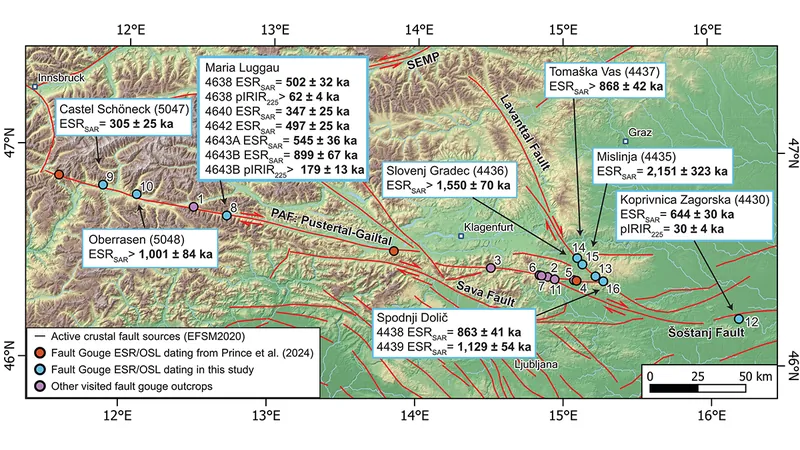
Revolutionary Techniques Unveil Secrets of Earthquake History in the Eastern Alps
2025-08-18
Author: Ming
Unlocking Earthquake Mysteries
How can scientists unearth the history of fault slips in regions like the Eastern Alps, where seismic activity is rare and geological evidence is often elusive? A groundbreaking study by Prince and colleagues is about to change the narrative!
Innovative Dating Techniques
Utilizing cutting-edge methods like optically stimulated luminescence (OSL) and electron spin resonance (ESR), researchers are now able to harness trapped electrons in mineral crystals—like quartz and feldspar. These revolutionary ‘trapped charge’ techniques work by activating these electrons through light and heat, revealing the hidden seismic past of fault rocks.
Investigation of Eastern Alpine Faults
Focusing on three significant faults—the Šoštanj, Periadriatic, and Lavanttal—this study dives deep into the geology of the Eastern Alps. By comparing the OSL and ESR signals of fault gouges from these locations, the researchers unearthed compelling evidence of earthquakes dating back millions of years.
Key Findings
The Periadriatic and Šoštanj faults show activity during the Quaternary period, stretching back roughly 2.6 million years. Notably, the Šoštanj fault has OSL dates revealing recent seismic activity, as young as 30,000 years ago. In stark contrast, the Lavanttal fault displays ancient and saturated ESR signals, indicating a long period of seismic dormancy.
Mapping the Past for a Safer Future
This landmark research illustrates the powerful potential of trapped charge dating when it comes to documenting the complex history of faults that may not show any signs of recent activity. By combining the insights from OSL and ESR, along with ESR saturation levels, scientists can better understand past fault behavior, a critical aspect of assessing earthquake risks and regional tectonics.
A Bright Future in Seismology
While deciphering the exact timing of individual earthquakes remains a challenge due to analytical uncertainties, this dual method approach brings us closer to piecing together the seismic puzzle of our planet, potentially paving the way for enhanced safety measures in earthquake-prone areas.




 Brasil (PT)
Brasil (PT)
 Canada (EN)
Canada (EN)
 Chile (ES)
Chile (ES)
 Česko (CS)
Česko (CS)
 대한민국 (KO)
대한민국 (KO)
 España (ES)
España (ES)
 France (FR)
France (FR)
 Hong Kong (EN)
Hong Kong (EN)
 Italia (IT)
Italia (IT)
 日本 (JA)
日本 (JA)
 Magyarország (HU)
Magyarország (HU)
 Norge (NO)
Norge (NO)
 Polska (PL)
Polska (PL)
 Schweiz (DE)
Schweiz (DE)
 Singapore (EN)
Singapore (EN)
 Sverige (SV)
Sverige (SV)
 Suomi (FI)
Suomi (FI)
 Türkiye (TR)
Türkiye (TR)
 الإمارات العربية المتحدة (AR)
الإمارات العربية المتحدة (AR)